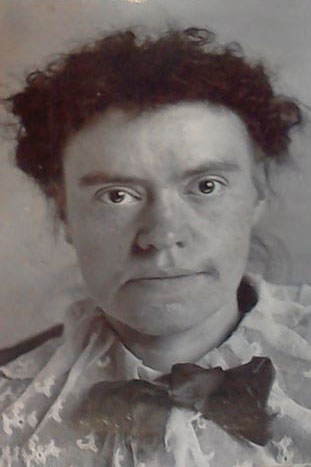b.1864 – d.1918
Intro
The majority of this story has been written by Sheila Cumming, who researched Ada for an article on the early patients of the Ewell Epileptic Colony as part of the Horton Chapel project. This is used with permission of the Horton Chapel Arts & Heritage Society. Early life has been added by further research by the Friends of Horton Cemetery.
The majority of the information recorded is taken from contemporaneous notes made by staff during the time the patients spent in Ewell Epileptic Colony. As such there will be descriptions, attitudes and actions which would not be considered appropriate today. These have been included to give an accurate representation of prevailing social conditions.
Early Life
Ada was born in 1864 in Notting Hill (Bayswater), London, to James, an upholsterer, and Anne (Annie) COPPING nee. BANKS.

The 1881 census does not show James, however Anne is not listed as Head of house, nor a widow, so it is likely he was simply out or at work premises.

1900’s
The 1901 Census shows Ada with her mother at the residence of Uncle Charles BANK. The final column (reserved for mental states or disabilities) states “Subject to Fits”.

Ewell Epileptic Colony
Ada had the distinction of being the first female colonist registered in the large heavy binder of records of female admissions to the Ewell Epileptic Colony.

She was 39 years old when she was admitted on 8th September 1903. Her diagnosis on arrival at the Colony was recorded as ‘epileptic imbecility with increasing mental enfeeblement’.
She described herself as home schooled, but had never been able to find long term employment. She gave details of her maternal uncle as next of kin, her parents both being deceased by the time of her admission to the Colony.
The visitors’ book shows that her uncle, a cousin and one of her brothers visited her on occasion, giving the impression of a caring family. Given the distance from their homes in North London and the lack of public transport, these visits must have constituted a substantial sacrifice of time and money on their behalf.
Ada’s history of epilepsy began when she was less than 1 year old, when her seizures were slight at first but as frequent as 5 times a day. She received treatment for almost 20 years at Queen Square, London which when established in 1859 was called The National Hospital for the Relief and Cure of Paralysis and Epilepsy. She also had the misfortune to have spent time in the Fulham Workhouse Infirmary, as her family undoubtedly had no money to pay for treatment. After time in the workhouse, the Ewell Epileptic Colony must have seemed a quiet and comfortable home, with fresh air, good food and medical care.
Ada’s case notes whilst she was at the Colony indicate that she was very violent during seizures and took a long time to recover, often being gloomy and bad tempered afterwards.
She had a moderate knowledge of current events, had good reactions, and was truthful and sociable, with a high sense of propriety. She could produce needlework of a high quality, give the current date, her full name, correct names to the months of the year, and multiply 3 times 13, despite ‘her appearance suggesting imbecility’. Current attitudes would consider imbecility a harsh and unacceptable label to apply to someone who laboured under the physical and mental effects of a debilitating illness.
Little seemed to alleviate Ada’s symptoms and throughout her time in the Colony she had an average of 3 seizures a week. For treatment she received regular doses of cod liver oil (constipation was believed to exacerbate seizures) and bromide of strontium, a chemical compound of crystallised powder which was the contemporary anticonvulsant treatment.
Unfortunately the records after 1910 are incomplete for Ada, although she was still shown as an inmate of the Colony in the 1911 census.

She may have been transferred to another of the hospitals in the Epsom cluster when the Colony was converted into a hospital for WW1 soldiers in 1918.
Ada died early in 1918, aged 54 and was buried on Feb 11th 1918, in the Horton Cemetery plot 736a.
BIBLIOGRAPHY SOURCE
- Surrey History Centre records relating to the Ewell Epileptic Colony, Ref 6292/27/8
- BMD and census records – Crown Copyright
- History of Queen Square Hospital
- Reed CAL. Constipation in Causation of Epilepsy and Migraine.
- JAMA. 1916;LXVI(12):912. doi:10.1001/jama.1916.02580380062034
- DeGiorgio CM, Miller PR, Harper R, et al Fish oil (n-3 fatty acids) in drug resistant epilepsy: a randomised placebo-controlled crossover study Journal of Neurology, Neurosurgery & Psychiatry 2015;86:65-70.
- Pourmasoumi M, Vosoughi N, Derakhshandeh-Rishehri SM, Assarroudi M, Heidari-Beni M. Association of Omega-3 Fatty Acid and Epileptic Seizure in Epileptic Patients: A Systematic Review. Int J Prev Med. 2018;9:36. Published 2018 Apr 5. doi:10.4103/ijpvm.IJPVM_281_16
- Use of Bromide of Strontium in Epilepsy: Br Med J 1895; 1 doi: (Published 18 May 1895) Br Med J 1895;1:1089




